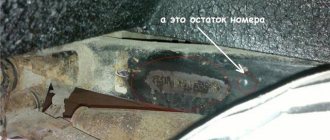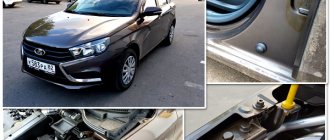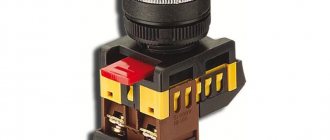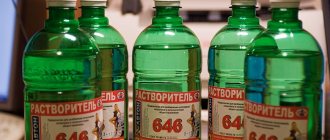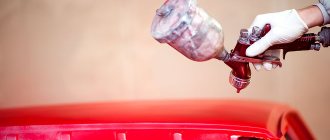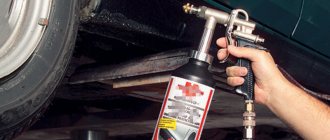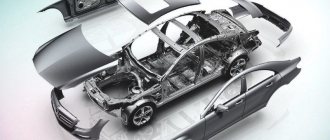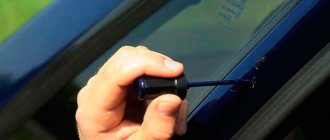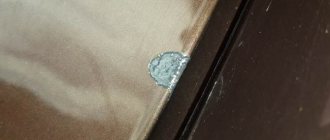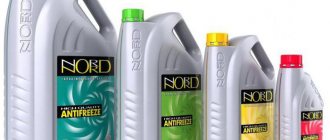It is quite difficult to find an owner of a vehicle who, at least once during the period of operation, was not interested in the issue of painting the body or decorative elements of the body.
One of the most popular paints in this case is light and dark gray metallic. Why such a need arises, what is special about this particular type of paint and how to properly organize this process when everything is done with your own hands will be discussed further.
Reasons and types of painting work
Based on the existing realities of our time, considering a car solely as a means of transportation is fundamentally wrong. The introduction of advanced technologies and design thoughts made the iron horse not only practical and functional, but also allowed it to be used for self-expression in society and among fellow motorists.
The paintwork of a car, whether matte or glossy, plays a huge role in this, performing both decorative and protective functions. Based on this, we can name at least two main reasons that encourage owners to think about painting their personal vehicles.
- Damage to paintwork. This is perhaps the main reason that necessitates the selection and application of paint that has a certain effect (matte or glossy). With such intense traffic, a rapidly increasing number of cars and, unfortunately, poor management culture, dents, scratches, chips, etc. are a common thing for any driver.
- New design. Despite the fact that painting a car matte or glossy light gray is a rather expensive and time-consuming procedure, there are car enthusiasts who spare no expense or effort to transform the color of their vehicle.
The type of painting classification is formed depending on its volume. Local. It is carried out if the reason for painting is the restoration of paintwork on some part of the body (for example, a scratch or a small dent on the fender, bumper, etc.).
In this case, there is no need to cover large areas or completely repaint the element. A fragment of the body is prepared (cleaned, puttied, primed), and when painting, the rest of the car is protected with film.
Partial. It is carried out if damage to the paintwork does not allow it to be restored in place. In this case, the damaged body element (for example, bumper, fender, door) is dismantled, completely cleared of the old coating, and its geometry is restored. Only after this is it painted in a light or dark gray matte color or metallic.
Information! Full painting is most often performed when the goal of the process is to create a fundamentally new design.
Who chooses metallic gray cars?
Metallic gray looks modern and stylish in any shade. Great for hot climates. Well visible on the road. It is no coincidence that every year it ranks first in new catalogs of automakers around the world. Cars in this color are chosen by sensible people, for whom individuality is more important than conformity to the norms of society. They easily remain calm under stress and have a calm driving style. The main motivation for choice is to remain unique, while not standing out in the crowd.
Owners of metallic cars are successful, balanced and reasonable people.
Differences between metallic car paint
Analyzing car paints and their characteristics, we can conditionally divide them according to the structure of the surface layer into those that have a matte or glossy color. If we consider the issue in terms of mass production, then the vast majority of models will have a metallic coating. The special shine effect of the car surface is achieved through individual paint additives. Among the main active ingredients are zinc, copper, aluminum, and brass pigments.
Interesting! Sunlight hitting such paint is reflected from metal particles, creating a feeling of shine (a matte shade does not have this effect).
In both mass and artisanal production, coatings with light gray and any other metallic can be divided into three types depending on the thickness and number of layers.
| Coating | Peculiarities |
| Single layer. | This paint contains varnish. This is the simplest option, but often visible defects (drips, bubbles, etc.) arise during the painting process. |
| Two-layer. | The paint is applied in two layers with a drying pause after each of them. This is the most common option, giving a mechanically resistant glossy finish. |
| Three-layer. | Not a very common type of painting due to its technical complexity. It can give an interesting pearlescent tint. |
Expert opinion
Ilya Vyacheslavovich
Consultant for body repair at krasymavto.ru
Ask a Question
The number of pigment elements, as well as their shape and relative position in the total mass of paint affect the degree of gloss.
For example, a light silver tint is obtained if the particles are located at a certain angle to the horizon (the angle of reflection is different).
Advantages and disadvantages
The performance characteristics of MDF kitchens painted with enamel with the addition of aluminum powder do not differ in any way from facades that are coated with regular enamel. For this reason, the advantages and disadvantages of such furniture are no different. Differences are observed in decorative properties.
Purple metallic kitchen
Metallic blue kitchen
Cinnamon metallic kitchen
Red metallic kitchen
Advantages
Furniture with metallic PVC film has many advantages:
- the surface of the products is absolutely smooth to the touch, so cleaning does not require much effort;
- on red, lilac, gray metallic, fingerprints are less noticeable compared to conventional headsets;
- the coating has durability, which manifests itself with proper care, the film is durable and will delight the homeowner with its technical properties for a long time;
- PVC is resistant to abrasion and various detergents;
- a variety of different textures and color palettes allows you to choose the best option for any home;
- the material is resistant to UV rays;
- PVC is characterized by environmental safety and ease of maintenance;
- the ability to implement almost any design solutions;
- One of the main advantages of film facades is their affordable cost compared to illogical finishing options.
Metallic kitchen in loft style
Metallic kitchen in yellow interior
Metal kitchen in a modern interior
Flaws
Along with numerous advantages, PVC also has some significant disadvantages:
- the film is capable of deformation and peeling off upon prolonged contact with moisture or under the influence of high temperatures;
- the surface of the material may remain damaged from abrasive cleaning compounds and mechanical influences;
- It is impossible to restore the defects that have appeared.
Manufacturers of furniture with film facades recommend using a hood in the kitchen interior, which will help extend the life of the furniture.
Metallic kitchen
Kitchen blue metallic
Metallic sea green kitchen
Popular gray colors and selection methods
The classification based on color is much broader. The problem of choosing the color and shade of paint affects every motorist who, either forced or of his own free will, decides to paint body parts.
Obviously, the most problems arise when local or partial staining is required. In this case, the paint has to be selected to match the existing paint coating, and this is a rather difficult task.
In practice, there are three main ways to determine color:
- Approximately. A special palette is used to compare shades. The chance of making a wrong choice in this case is quite high.
- By VIN code, body number. The color and type of coating are usually included in the identification number located on a special plate (nameplate), which is unique for each car.
- In a special software environment. Mathematical algorithms allow you to most accurately determine the required color, hue, depth, and saturation.
Light or dark gray is the most problematic color to select, so a computer program is indispensable.
The silver shade is statistically the most popular. It combines not only neatness and attractiveness, but is also quite good in practical terms, since it hides scratches better than others.
Metallic kitchen - how to achieve the desired effect
You can achieve a similar effect on the facades of kitchen furniture in several ways.
- The steel surface, treated appropriately - not glossy, but not matte either - creates a silvery sheen. Metal kitchens are often called metallic, which is not entirely true.
- Acrylic glossy panels can reproduce a metallic sheen. The decorative effect of the material is much higher, so any shade enhanced by shimmer is possible: cinnamon, pink, lilac, or orange.
- Painted facades are real metallic. The surface is coated with a special enamel paint containing aluminum powder as a component. It is this that creates the special silvery shimmer. Most often, painting in two layers is used, but other interesting options are possible.
For example, if you apply transparent mother-of-pearl on top of a two-layer coating, you get the most glamorous kitchen option - pearl. This shine is especially effective in combination with complex colors - purple, lilac, pink. Both white and champagne can be pearlescent - such a light shade creates a good background for the pearly shine.
Three-layer painting allows you to achieve a chameleon effect: when the lighting angle changes, the color of the facade changes. For this, darker, more saturated colors are used - burgundy, blue, lingonberry, cinnamon. This effect makes an exceptional impression on radius facades, where changing the surface, even without changing the lighting, creates a multifaceted play of light and shadow. The photo shows a glamorous version of the kitchen with a burgundy-colored facade.
Burgundy chameleon kitchen made of MDF
White, champagne, silver, light pink are completely unsuitable for three-layer painting: the shades are too light, so the color play will be poor. Black is also not suitable: there are no shades here.
Subtleties of applying a two-layer metallic shade
Painting a car yourself with light gray or any other metallic is quite a responsible undertaking. To achieve the desired result, you must strictly follow all recommendations and the order of work.
First of all, you should prepare the required surface for painting. It all depends on the scope of the problems or what goals are being pursued. If this is local or partial painting, then the surface must be cleaned from the old coating to the base metal.
Important! This is a mandatory condition, since putty, primer, and paint contain solvents, which can ultimately lead to the new coating peeling off along with the old one.
Next, the surface is straightened and puttied to restore the original geometry. Next, a layer of primer is applied to ensure the necessary adhesion to the paint.
Expert opinion
Ilya Vyacheslavovich
Consultant for body repair at krasymavto.ru
Ask a Question
If there are pockets of corrosion, a special anti-corrosion primer is applied before puttingty.
After this, the actual painting of the car begins. In the case of a two-layer metallic, the base is applied first, and after some time the finishing varnish is applied. Basic gray paint is applied in 2-3 layers.
There is a pause between layers to allow the coating to dry. An additional indicator of readiness can be a matte color - this means that the solvent has evaporated. The varnish is also applied in 2-3 approaches, which allows each layer to dry.
After the painted surface has completely dried, the car is ready for use.
Composition of conventional car enamels
Before talking about the features of metallic, it is necessary to remember the composition of ordinary ordinary enamel. It consists of three basic components:
- dye;
- connecting link;
- solvent.
The dye, or pigment, is a composition in the form of a fine powder. This is the component that forms the color of the paint. In addition, pigments may have other properties. Thus, some dyes can additionally protect the body surface from corrosion.
The binder refers to the layer that holds the powdered dye on the surface. When the process is completed and the enamel has dried, it is due to this connecting link that an even shiny layer is formed on the painted surface.
The main task performed by the solvent is to make the paint liquid. This is necessary for more convenient application of it to the body. After all, as a rule, paint is applied using sprayers. Although these components occupy a considerable amount of space in the enamel, its main function is still the dissolution of paint. In addition, after finishing painting, the composition should quickly evaporate from the surface. And often car enamels manufacturers use quickly evaporating liquids as solvents.
We have listed the main components of traditional car enamels, which are used to paint most cars as standard. And then we will look at how metallic paint for cars differs from them.
Currency
A rather rare shade of “Currency” was used in the color of early versions of 2114. “Currency” first began to be used in the production of “nines” and “eights” back in the 90s.
Now this variation is designated by code 310 . This metallic gets its name due to the presence of a faint green tint, like on dollar bills.
In sunny weather, the metallic “Currency” looks rather boring, but when the body is dirty, it is not much different from other gray options on the “four”. In combination with white wheels, “Currency” looks more interesting.
There have been many variations of gray bodywork on VAZ models throughout the history of production. According to car owners, Sochi is considered the most beautiful, which does not lose its richness in any weather. The exact year in which each type of color began to be used is not publicly available. If you have codes, you can purchase paint yourself, but we recommend that you play it safe and take the gas tank door when visiting the store, because... it is easy to remove.
From bicycle to car
A similar composition in the USSR was not used on car bodies. In the USSR, “Victory” and “Volga” cars were treated with simple colors - white, gray, beige. Metallic came to the big country on bicycle frames produced in Kharkov. The frames sparkled with aluminum powder, reflecting rays of light from under a thick film of enamel. It was nothing more than a first generation single coat metallic. It differed in that aluminum powder was contained throughout the entire thickness of the paint, which was approximately 50 microns.
Judging by the reviews, this paint was considered interesting back then. But many were put off by its weak resistance to various influences. During use, it also wore out - the powder oxidized and went with the wind. The surface acquired dull white shades. In order to avoid this, experts have developed a two-layer system. A clear varnish was applied over the paint.
This is how two-layer metallic was born. The paint turned out to be more durable and durable, as well as effective. The varnish served as a magnifying glass. Then the paint began to be used for cars.
